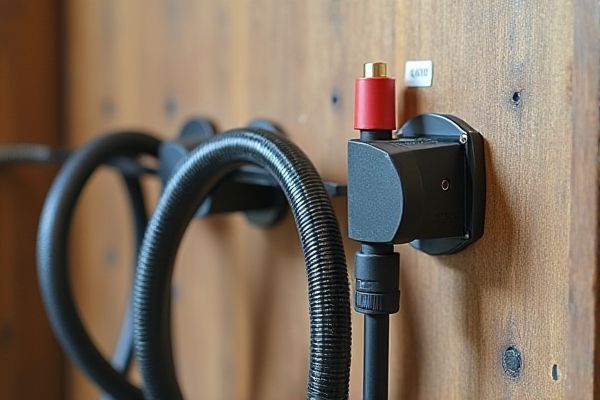
Cable organizers prevent tangling and protect electrical cords, enhancing safety and prolonging device lifespan, while hose organizers keep garden or industrial hoses neatly coiled and accessible, preventing damage and kinks. Discover how choosing the right organizer can streamline Your space and improve efficiency by reading the full article.
Table of Comparison
| Feature | Cable Organizers | Hose Organizers |
|---|---|---|
| Purpose | Manage and store electrical cables and cords | Store and manage garden or water hoses |
| Material | Plastic, silicone, rubber, metal | Plastic, metal, heavy-duty fabric |
| Common Types | Cable ties, clips, sleeves, reels | Hose reels, hooks, carts |
| Durability | Moderate, designed for indoor use | High, designed to withstand outdoor conditions |
| Usage Environment | Indoor offices, homes, entertainment systems | Outdoor gardens, yards, garages |
| Load Capacity | Light to medium weight cables | Heavy and thick hoses up to several hundred feet |
| Maintenance | Low, occasional dusting | Medium, may require cleaning to prevent mold and kinks |
| Cost Range | $5 - $30 | $20 - $150+ |
Introduction to Cable and Hose Organizers
Cable organizers streamline workspace efficiency by neatly bundling electrical and data cables, preventing tangles and reducing wear for electronics and IT infrastructure. Hose organizers provide secure storage for garden, air, or hydraulic hoses, extending lifespan by minimizing kinks and abrasion in landscaping, automotive, and industrial settings. Both products optimize space management and maintain system integrity in their respective applications.
Key Differences Between Cable and Hose Organizers
Cable organizers are designed to manage electrical wires and data cables, featuring materials like Velcro straps, cable sleeves, and clips that prevent tangling and improve workspace safety. Hose organizers, on the other hand, are built for managing garden or industrial hoses, often made from durable plastics or metals with hooks, reels, or brackets to support heavier weight and outdoor conditions. The key differences lie in their material strength, environmental resistance, and specific design features tailored to either flexible cables or bulky, fluid-carrying hoses.
Materials Used in Cable vs Hose Organizers
Cable organizers are commonly made from flexible materials such as silicone, nylon, and Velcro, which provide lightweight and easy-to-manage solutions for bundling wires and preventing tangles. Hose organizers typically use more durable materials like heavy-duty plastic, rubber, or reinforced fabric to withstand outdoor conditions and the pressure of water hoses. Your choice between cable and hose organizers should consider the material durability and flexibility based on whether you need indoor cable management or robust hose storage.
Design and Functionality Comparison
Cable organizers feature flexible compartments or clips tailored to manage electrical wires neatly, preventing tangles and enhancing safety. Hose organizers are designed with robust hooks or reels to support heavy-duty garden hoses, facilitating easy winding and storage. Your choice depends on whether you need streamlined electronic cable management or sturdy, space-saving solutions for bulky hoses.
Organization Efficiency: Cables vs Hoses
Cable organizers enhance organization efficiency by preventing tangling, reducing clutter, and enabling easy access to individual cables, which minimizes downtime during maintenance or adjustments. Hose organizers are specifically designed to manage bulkier, heavier hoses, preventing kinks and wear while improving storage space and prolonging hose lifespan. Compared to hose organizers, cable organizers typically offer greater precision for small-scale cable management, while hose organizers provide robust solutions tailored for outdoor or industrial environments.
Installation and Ease of Use
Cable organizers typically feature adhesive backing or clips for quick, tool-free installation, making them ideal for managing electrical cords in tight spaces. Hose organizers often require wall mounting or stakes, which may involve drilling or securing hardware, adding complexity to setup. Both prioritize ease of use, but cable organizers excel in rapid deployment, while hose organizers provide more robust support for heavier, bulkier items.
Space-Saving Advantages
Cable organizers maximize space efficiency by bundling wires neatly, reducing clutter in tight areas such as desks or entertainment centers. Hose organizers keep garden or workshop hoses coiled compactly, preventing tangling and freeing up floor or wall space. Your choice depends on whether you need to optimize storage for electronic cables or physical hoses.
Durability and Longevity Considerations
Cable organizers are typically made from flexible silicone or plastic materials that resist wear and tearing, ensuring long-term use in various environments. Hose organizers often feature heavy-duty metal or reinforced plastic components designed to withstand outdoor elements, UV exposure, and pressure from hose coils, providing superior durability. Your choice should depend on the specific stressors and environmental conditions each organizer will face to maximize longevity.
Maintenance and Cleaning Tips
Cable organizers require regular dusting and occasional wiping with a damp cloth to prevent dirt buildup and maintain flexibility. Hose organizers need periodic draining and drying, especially after outdoor use, to avoid mold growth and material degradation. Both types benefit from storing in dry, cool locations to extend longevity and ensure optimal performance.
Choosing the Right Organizer for Your Needs
Cable organizers provide effective solutions for managing electrical cords, USB cables, and charging wires, ensuring safer and clutter-free spaces in offices and homes. Hose organizers are specifically designed to handle garden hoses, air hoses, and other flexible tubing, preventing kinks and prolonging hose lifespan. Selecting the right organizer depends on the item type, usage environment, and the level of flexibility or durability required for efficient storage and accessibility.
 homyna.com
homyna.com